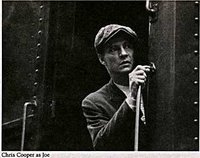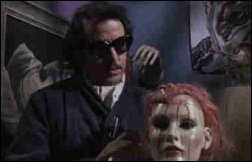
Well, against all odds, I did make it into Beverly Hills to see
Three Times Saturday night. I even got free parking! Despite some faint hope of being joined at the Laemmle Music Hall by the Mysterious Adrian Betamax, I saw the Hou Hsiao-hsien film by myself.

But that’s okay—it’s a nearly two-and-a-half hour movie in which
Shu Qi and/or
Chang Chen are on screen for the entire running time. As photographed by Hou’s regular cinematographer Pin Bing Lee, these are not actors that are difficult to look at, and Hou’s leisurely pace allows them and Pin’s wondrously textural imagery to wash over the viewer with sublime abandon. Sorry, M.A.B., he said with a wink, but what better company could I have asked for? I hope to have some thoughts on that film, and a couple others I saw over the weekend up and ready to read in a couple of days.

Meanwhile, answers to Professor Van Helsing’s quiz keep pouring in, largely generated by all the new exposure afforded this humble blog by fellow blogger, critic and new friend
Jim Emerson. In fact, there are so many lists of answers posted and linked to in the comments column of the quiz that I’m going to have to take steps to rethink my approach to the traditional post-quiz answer roundup. Back in the days when getting 15 responses was more than I expected, putting together a roundup which touched on just all about all the answers in one way or another was a doable feat and one I looked forward to. But with the Van Helsing quiz, not only did I trump my own roundup by getting overly excited by the
first batch of responses, after I turned that I post in I watched at as nearly 20 more flowed through the gates. And the gates are still open (hint, hint, M.A.B., psaga!) for more. I am now thoroughly intimidated at the prospect of trying to create a readable digest from so many responses and giving such a high percentage of them their due. I think I’ve come up with a solution that won’t take two weeks for me to put together, or two weeks for you to read, but only time will tell if I’ve succeeded. Success or not, it’s coming just around the bend.
There are other things I’ve got on my mind and on my plate, original material-wise. But the Internet is such a vast and wonderful resource that I just can’t help but put together another set of juicy links to tide you over until I can get my own act together again. I really do love linking to all these great articles and blogs—I discovered most of these pieces through the same method, courtesy of others who took the time to post them on their sites. But there is only one
Green Cine Daily, and not only could not I possibly compete with David Hudson and his comprehensive list of daily links, I wouldn’t want to. He’s just too good at it. That said, he provides an excellent example for those of us who, like the old man played by
Jack Gilford in the Cracker Jacks commercial, are into
sharing. A couple of these I was directed to by David and
Green Cine Daily. Others were pointed out to me by friends or other blogs. But regardless of where I heard about them, I want you to hear about them too. And now some more sharing…

Yes, there are a few of us who are eagerly anticipating the release of Robert Altman’s latest film,
A Prairie Home Companion, starring Garrison Keillor, Meryl Streep, Lily Tomlin, Kevin Kline, Woody Harrelson, Lily Tomlin and Lindsay Lohan, among many others. The film recently closed the San Francisco Film Festival and has been getting good-to-very good reviews as it is has made the rounds over the past couple of months. But one of the big stories about
Prairie’s production was the on-set presence of
Paul Thomas Anderson, director of
Boogie Nights and
Magnolia, who served as an officially credited “stand-by director” during the shoot. Of course, this led to all kinds of speculation that Altman was on his last legs, that he was expected to keel over at any minute—the supposition being, I suppose, that in the event of Altman’s incapacitation or collapse, Anderson would pick up the megaphone and keep the cameras rolling as they hauled the famous director’s wheezing body off in an ambulance.

But there’s nothing like a memorable, and relatively vigorous, walk-on at the Oscars to accept a lifetime achievement award, and to reveal a heart transplant that took place 10 years ago, to set people’s heads straight. Of course, the real story all along is that Altman, being healthy but also 80 years old at the time the movie was filming, was a bit of a risk for the insurance company due to his advanced age, and as a contractual precaution they insisted on someone to be present just in case. Anderson, a friend of Altman’s whose own films pay testimony to the elder director’s profound influence, got the call, and he talks about it with Henry Rollins this week on IFC’s
The Henry Rollins Show.

The episode originally aired last Saturday night and will be repeated two more times, this coming Thursday, May 18, at 8:00 p.m. and 11:00 p.m. PST. And speaking of good stuff on IFC, from a completely personal perspective, of course, the ever-eclectic channel is offering, among many others things, a chance to catch up with John Sayles’ rarely seen
Matewan
(it shows Wednesday, May 17, at 12 noon and again Thursday, May 18, at 4:30 a.m., and several times again throughout the month); David Thowy’s largely unseen undersea thriller
Below (which was vastly underrated by those who did see it), which shows Wednesday, May 17 at 10:00 p.m. (and throughout the rest of the month);

and, though I may regret it, William Lustig’s notorious
Maniac starring and co-scripted by the late, great character actor (and character face) Joe Spinell. This scalp-and-splatter classic, which I’ve never had the nerve to sit through, despite the presence of the lovely Caroline Munro, screens throughout the month as well. You can check IFC’s May
schedule for further dates and times on these and many more titles, most of which will probably far more worth your time than, say,
Maniac.
The ever-amazing Tom Sutpen has done it again. It was only a few months ago that he posted a terrific audio recording of Pauline Kael reading her infamous anti-auteur theory “Circles and Squares” essay to a rapt audience. Now Tom has added another rare, irresistible recording to match the first one in significance and sheer fun.



The post is called
”When FilmCritics Gather”, and it’s a real doozy—on the same stage,
Dwight MacDonald, whom Tom, in the delightful text he writes to provide some context for the audio, describes as the “former
Partisan Review editor and recidivist Trotskyite,”
Pauline Kael, just before her appearance on the national stage and around the time (1963) when she was programming a Berkeley art-house and enraging listeners on KPFA Pacifica Radio, and famously vicious film/theater critic
John Simon, whom Tom says was once “rather unkindly” described by a friend as “the Slobodan Miloševic of arts criticism (unkind and also unfair; to the best of my knowledge, Miloševic was never heard to exclaim 'Gays in the theater! I can't wait until AIDS kills them all!').” And that’s just Tom’s lead-up! The recording is in two parts and runs about 73 minutes in toto, and I can’t wait to get a chance to stop sampling bits and pieces and just sit down and listen to it from start to finish. It should be a fascinating document from a time when film criticism was about to reach popularity commensurate to the seriousness with which film had begun to be taken in the late ‘60s, a time when film criticism had yet to be taken for granted or, as it is increasingly in our day, pooh-poohed as being irrelevant and overly intellectual by the “I-just-want-to-be-entertained” crowd, or even out-and-out threatened with extinction by the gathering storm cloud of entertainment coverage and junket “reviews.”
Speaking of terrific modern film criticism, which roughly translates into a film critic who takes film and writing as seriously as the old fogies (see above) did while never losing touch with his own youthful vitality and rigorous standards, Matt Zoller Seitz’s
The House Next Door has finally posted Jeremiah Kipp’s fantastic interview with one of film criticism’s best-kept secrets,
Film Freak Central’s
Walter Chaw. I’ve read and treasured Chaw’s acerbic wit and his no-holds-barred approach for years—he champions art films, which gets him branded an elitist and a snob by readers who don’t want to bother following him down those paths, but who also conveniently ignore the raves he’s given to arty fare like
Spider-Man 2, V for Vendetta and Peter Jackson’s
King Kong. (Chaw’s review of
Kong was a rare occasion when I thought one of the writers I love to read on a weekly basis “got it,” who didn’t roast the movie based almost solely on its length, who understood what Jackson was going for, where he was coming from, and went with him all the way. His review sent me into the theater on a cloud of expectations which were handily met.) But, as Kipp says in his intro to the interview, “when you find an online critic with writing chops as strong as Chaw's, you don’t want to keep him to yourself. Where many Internet-based reviewers mimic the acerbic aspects of Pauline Kael, Chaw takes his caustic, occasionally hostile wit so far that one sometimes wonders if the Paulettes might ask him to tone it down a little. Barbed language aside, though, Chaw's approach owes less to the obvious film critic models than to satirist, science fiction author and cultural pundit Harlan Ellison, who famously said, ‘Not everyone is entitled to an opinion. They are only entitled to an informed opinion.’” Chaw has those and more. Enjoy his talk with Kipp
here.

Frequent
SLIFR commenter and fellow blogger
Robert Hubbard is back from a film shoot and today alone sent me two bits of information that I have to pass along. First, for those whose completism re David Lynch’s
Twin Peaks is not quite complete, Robert directs me (that is, us) to
Not Coming to a Theater Near You’s
Guide to Twin Peaks, which, in addition to its stunning page design, provides links to detailed essays (with accompanying unsettling screen grabs) for each episode of the much-too-short-lived ABC TV series. Just the thing to get that fire walkin’ with me again.
Robert also alerts me to an upcoming event that will be of interest to
SLIFR readers in the New York City area, specifically Brooklyn, coming in June. In the wake of the passing of director Richard Fleischer, film critic Elliot Stein will host an evening at the Brooklyn Academy of Music, as part of his “Cinemachat” series, which will focus on Fleischer and his films. Stein will screen Fleischer’s well-regarded crime picture
Violent Saturday, starring Victor Mature, Lee Marvin, Ernest Borgnine, J. Carroll Naish and a host of others, in July.

And then, on June 14, Stein will host a
very rare big-screen presentation of Fleischer’s notorious 1975 drama
Mandingo. (Here’s yet another
point of view on the film that may pique your interest in seeing it on the silver screen.) This is the sort of event that makes me wish I could afford plane tickets at the drop of a hat. But if you’re in Brooklyn in June, consider yourself enlightened. (Check on the full Cinemachat schedule
here.)

If you’re a subscriber to the
Los Angeles Times, you’re probably already aware of David L. Ulin’s consideration of above-the-title screenwriter
Charlie Kaufman. But if you’re not, you may want to be, not only so you can argue with Ulin as to whether Kaufman is the greatest writer of his generation or not, but also so you can read his sublime description of a child’s birthday party uncomfortably attended by himself and his wife which unexpectedly slips into Kaufman territory itself.

I haven’t had a chance to read it yet myself, but fellow blogger
Andy Horbal directs us to a piece written by Armond White for
Slate entitled
”Dear Wes Anderson, Why Does It Take You So Long to Make a Movie?”. Love him, hate him, or love to get exasperated by him (I’m all three), White’s take on Anderson and a whole crop of filmmakers he brands American Eccentrics should be well worth the reading time. Horbal, by the way, also offers up some further observations and links re the recent dismissal of
Jami Bernard and, as it turns out, Michael Wilmington too.
Finally, courtesy of
Anne Thompson comes word of an addictive new film rating site called
Criticker. Thanks, Anne! But really, these bastards! Don’t they know I already spend too much time rating movies on Netflix? Doesn’t anyone want me to sleep?! ;)
Speaking of which…




































































